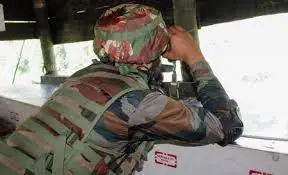As India struck terror targets inside Pakistan and PoK, T-72 tanks, BMP-2 armoured vehicles moved up to LoC

New Delhi, May 21, 2025:
India has taken decisive action against cross-border terrorism. On Monday night, Indian forces struck terror camps inside Pakistan and Pakistan-occupied Kashmir (PoK). Soon after, the Army deployed T-72 tanks and BMP-2 vehicles near the Line of Control (LoC) to reinforce forward positions.
Swift Action Based on Strong Intelligence
The strikes targeted several terrorist launch pads operating near the LoC. According to military sources, the camps were active and preparing to push militants across the border. Indian intelligence confirmed the presence of high-value terrorist assets in those camps.
Rather than waiting for an attack on Indian soil, the Army acted quickly. Precision strikes destroyed several key targets. This preemptive move shows a clear shift in India’s strategy—attack before the threat grows.
Armoured Vehicles Roll Out Along the LoC
In a visible show of strength, the Army moved its T-72 Ajeya tanks and BMP-2 Sarath infantry vehicles to forward bases near Rajouri and Poonch. This signals India’s readiness to counter any response from Pakistan.
The T-72, equipped with a 125 mm gun, gives India superior firepower in rugged terrain. The BMP-2, fitted with guided missiles and automatic cannons, supports infantry movement and provides protection.
This mobilization strengthens India’s defence posture and acts as a strong warning against further provocations.
Foiled Infiltration Attempts Prompted Action
In recent weeks, Indian troops stopped several infiltration attempts in sectors like Kupwara and Poonch. Security forces intercepted communications between terrorists in PoK and handlers across the border. These messages pointed to planned attacks in Jammu and Kashmir.
The Army’s response followed this intelligence trail. Officials believe the strikes disrupted infiltration plans before they could unfold.
Top Leadership Supports Military Response
India’s political leadership stood firmly behind the Army. Defence Minister Rajnath Singh stated that India will “take all necessary steps to defend its sovereignty.” He praised the forces for their alertness and discipline.
A senior official said the military has full freedom to act against any threat. The government continues to support quick, decisive responses to cross-border terrorism.
Focus on Terror Camps in PoK
Sources say the strikes targeted camps near Muzaffarabad and Mirpur. These locations are believed to shelter groups like Jaish-e-Mohammed and Lashkar-e-Taiba. India has long accused Pakistan of supporting such outfits.
Satellite images and drone footage had shown recent movements at these sites. Officials believe those movements were part of efforts to revive infiltration before the monsoon season.
The targeted strikes disrupted this buildup. Early reports suggest heavy damage to infrastructure and loss of terrorist assets.
Pakistan on Alert, But No Major Retaliation
After the strikes, Pakistan’s forces increased their alert levels. Pakistani media outlets accused India of aggression. However, India has not officially confirmed the operation, sticking to its policy of strategic silence.
The LoC remains tense. Some sectors reported minor gunfire exchanges, but no major retaliation occurred. Indian forces remain on high alert in all forward areas.
Global Response and Regional Stability
The international community is watching closely. Countries like the United States and France have consistently backed India’s right to defend itself against terrorism. Most global powers view India’s actions as defensive, aimed at protecting civilian lives.
Security experts say that India’s strong military posture helps maintain regional stability. A quick, forceful response sends a message that terror networks won’t go unchallenged.
India’s Defence Policy: From Reactive to Proactive
This operation marks a shift in India’s approach to terrorism. Rather than waiting to be attacked, the armed forces are hitting back at the source. By targeting camps across the LoC, India has changed the game.
Military analysts believe this doctrine boosts deterrence. When enemies know India will strike first, they will think twice before sponsoring terror.
Civilians Along the Border Remain Calm But Alert
People living in border villages remain calm but cautious. Many have seen such buildups before and trust the Army to protect them. Authorities have increased patrols and tightened movement in sensitive areas.
Local leaders are also working with the administration to keep schools and markets running. The aim is to maintain normal life despite the heightened military presence.
Conclusion: India Shows Strength With Clarity
India’s latest move reinforces its commitment to national security. By striking terror camps and deploying armoured units, the Army has sent a clear message—India won’t tolerate cross-border threats.
The swift and precise operation shows that India is not only prepared to defend itself but is also willing to act before danger escalates. With T-72 tanks and BMP-2 vehicles now stationed at key locations, the Indian Army stands ready.
As the situation unfolds, citizens can trust that India’s armed forces remain vigilant, proactive, and committed to peace through strength.






